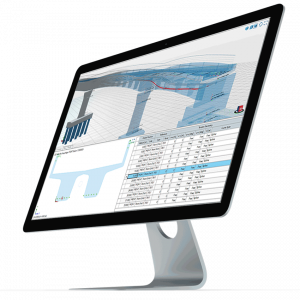ONE PARAMETRIC MODEL FOR GEOMETRY, ANALYSIS, DESIGN AND DETAILING
Allplan Bridge is the worlds first complete solution for Bridge engineers, reducing time-consuming project changes to a bare minimum by offering detailed geometrical and structural analysis in one Model across an entire BIM Workflow.
WHAT IS ALLPLAN BRIDGE?
Allplan Bridge is a powerful parametric BIM solution for bridge engineers, combining all phases of bridge design from highly detailed model creation, including prestressing tendons, to the integration of the construction process, structural analysis with code-based design, and drawing production, in one solution.
> Tailored solutions for different bridge types, such as precast girder bridges, and all parts of super and substructure including bridge equipment.
> Fully parametric model, including intelligent reinforcement, enabling easy templating and fast and precise model changes for maximum flexibility and superior project delivery.
> Interoperability of the geometrical and analytical model for more efficient project collaboration.
THE ALLPLAN BRIDGE WORKFLOW
THE WORLD’S FIRST COMPLETE SOLUTION FOR BRIDGE ENGINEERS

1. AXES DEFINITION
In Allplan Bridge, you can adopt the data from an existing design (using LandXML data format) or define it manually
2. CROSS-SECTION MODELING
You can define any cross-section and determine the geometry with its dependencies and variables. These parametric cross-sections can be adapted at any time and be saved as a template and be reused.
3. REFERENCING STANDARDIZED PROFILES
Standardized and repetitive profiles such as longitudinal stiffeners for steel and composite cross-sections can be easily positioned parametrically.

4. 3D MODEL CREATION WITHOUT COMPROMISE
The digital model In Allplan Bridge is completely parametric. Changes can be made at any time. The dependent objects are automatically adjusted. Allplan Bridge is suitable for all phases of work – from the concept to the detailed design.

5. PRESTRESSING MODELING MADE SIMPLE

6. PLANNING TENDON STRESSING SEQUENCE
A stressing sequence can be defined for each tendon specified in the model.

7. 4TH DIMENSION: CONSTRUCTION SCHEDULE DEFINITION
Time as the 4th dimension is considered by easily specifying the construction process. The construction plan is divided into several phases and further into individual tasks. The related structural components are interactively assigned to these tasks.

8. AUTOMATIC DERIVATION OF THE ANALYSIS MODEL
Thanks to breakthrough technology, Allplan Bridge automatically generates the analysis model from the geometrical model. This greatly reduces the amount of work and the susceptibility to errors

9. ASSEMBLING CONSTRUCTION SEQUENCE CALCULATION
Allplan Bridge analyses the defined construction schedule and sets up all necessary calculation definitions in an automated process, like load cases, element activations and calculation actions.

10. CREEP, SHRINKAGE AND RELAXATION
In Allplan Bridge the calculation of creep and shrinkage of concrete and relaxation of prestressing steel is code-compliant.

11. APPLY ADDITIONAL LOADS
The weight and the position of superimposed dead loads (like sidewalk, road pavement, etc.) are automatically retrieved from the geometrical model. Additional loads, like temperature change or wind loads, can be defined and applied easily as well.

12. TRAFFIC LOAD DEFINITION
Traffic loads can be defined/applied in a very comfortable way. On the one side, the traffic load is automatically applied in accordance with the selected standard. On the other side, the generic approach of live load definition implemented in Allplan Bridge allows the user to consider any type of moving load.

13. CALCULATION AND EVALUATION OF INFLUENCE LINES
With Allplan Bridge, the most unfavorable effects due to traffic loads can be determined quickly and easily using the theory of (related) influence lines

14. CALCULATION OF EIGEN MODES
The natural modes of the structure are calculated on the undamped system by determining the roots of the homogeneous equation system.

15. RESPONSE SPECTRUM ANALYSIS
The analytic solutions for typical structures and unit impacts are provided in the design codes as relevant response spectra, specifying the relevant proportionality factors for the individual eigenmodes dependent on the natural frequency.

16. SUPERPOSITION
The user-friendliness of the superposition in Allplan Bridge is groundbreaking. The schematic definition of the superposition combines maximum flexibility with optimal overview.

17. COMBINATIONS
The definition and visualization of combination in table form gives the user an overview not only of the defined load factors but also of different types of combinations.

18. PERFORMING STRUCTURAL ANALYSIS
A global static analysis based on the Bernoulli beam theory is performed for all manually defined and automatically generated calculation actions in the previously defined construction schedule.

19. CODE-BASED DESIGN
After the global effects have been calculated and the corresponding envelopes generated, the user can perform the code-dependent design to determine the required reinforcement area.

20. PARAMETRIC OBJECT PLACEMENT
Objects from the Allplan Engineering library can be referenced in Allplan Bridge to add further details such as lamp posts or anchor devices of tendons to the bridge model.

21. CHANGES MADE IN NO TIME AT ALL
Allplan Bridge helps you to manage the inevitable changes that occur during the design process. The parametric model description is an ideal base for adapting design changes for geometrical and analytical model.

22. FREE FORM MODELING
Powerful 3D modeling functionality allows to implement all bridge details without compromise: simply, flexible, and with the highest level of precision. The Parasolid® modeling kernel from Siemens handles intricate free-form geometry based on B-Splines and NURBS as well as for standard tasks such as joints, cut-outs and drainage with ease.

23. REINFORCEMENT MODELING
With Allplan, even challenging bridges with double curvature and varying cross-sections are reinforced conveniently and rapidly. The reinforcement is defined in different cross-sections and the transitions between the cross-sections are described with paths. Various rules can be defined, such as how the reinforcement joints are to be carried out. Using this information, the reinforcement is automatically generated.

24. CREATE DRAWINGS
Elevations, longitudinal sections along any path and transverse sections are derived from the digital bridge model. CineRender from Maxon is used for realistic visualizations. Allplan’s powerful layout and design tools are used to create high-quality construction documentation.

25. CREATE REPORTS
The digital bridge model contains a multitude of information. Comprehensive reports with dimensions, areas, volumes, weights and quantities are available at the touch of a button.

26. SMOOTH DATA EXCHANGE
Integrating road data used for road/bridge alignment is easily achieved via ALLPLAN’s open BIM platform Allplan Bimplus. The bridge engineer must only take over the road data and can immediately start with the bridge design. Once the design is completed, the parametric model can be transferred in Allplan Engineering and to analysis software.

27. EXCHANGE THE ANALYTICAL MODEL
The analytical model generated in Allplan Bridge can be shared with other analysis solutions by uploading it to the cloud-based BIM platform Allplan Bimplus.

28. BIM COLLABORATION
With the combination of Allplan and the cloud-based BIM platform Allplan Bimplus, everyone involved has access to the latest design, anytime, anywhere and with any device. BIM coordination happens interactively on the digital bridge model. Discrepancies are detected at an early stage and resolved jointly. This is an important contribution to ensuring that the construction project is completed on time and within budget.
ALLPLAN BRIDGE 2023
A NEW ERA IN PARAMETRIC BRIDGE MODELING.
SHAPING BRIDGES IN A BETTER WAY WITH ALLPLAN BRIDGE 2023


TRY ALLPLAN BRIDGE FOR FREE
> Free parametric modeling – flexible and time saving
> Easily design to key national standards (German, Spanish and French)
> Avoid repetitive tasks with powerful templating and improved project collaboration
> Smoother analytical interoperability
> Improved collaboration with Allplan Engineering
Test the full version of Allplan Bridge 2023 for 14 days free of charge and with no obligation. Simply download the software and experience all the advantages for yourself.
ALLPLAN is part of the Nemetschek Group.
-
Singapore: ALLPLAN Software Singapore PTE. LTD. |
4 Battery Road #25-01, Bank of China Building
49908 Singapore - customercare.singapore@allplan.com

